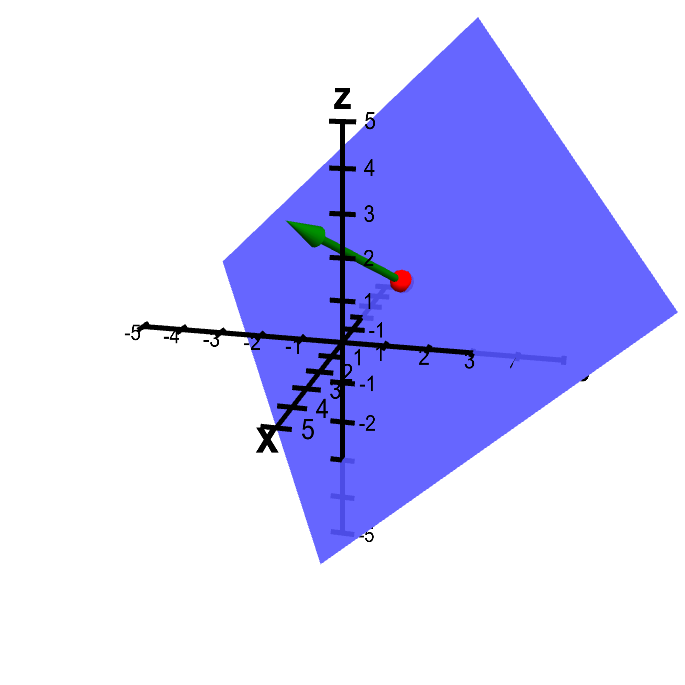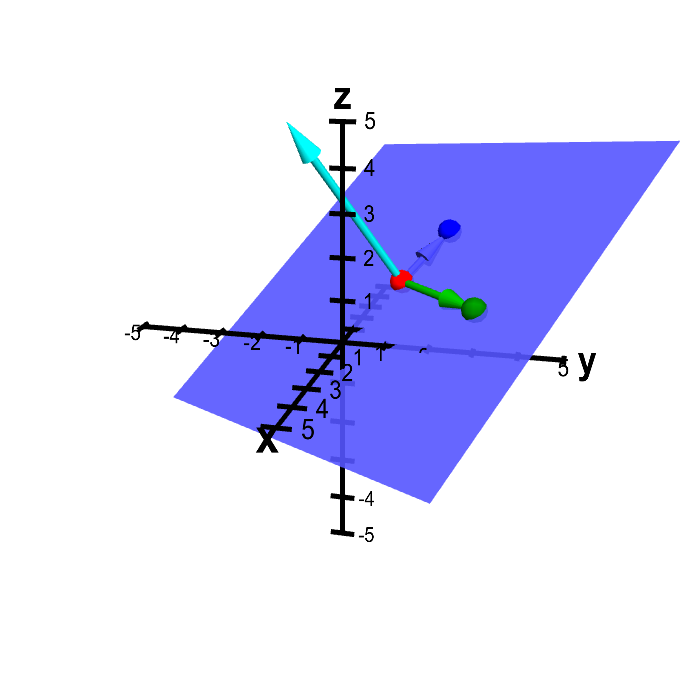how to find the normal vector of a plane with 3 points
In this page, nosotros outline ways to specify a airplane.
Plane determined past point and normal vector
Given a point $P$, there are many planes that contain $P$. Withal, assuming that we are living in 3-dimensional space ($\R^3$), a aeroplane is uniquely determined if we likewise specify a normal vector $\vc{due north}$ (i.e., a vector that is perpendicular to the plane).
The following applet illustrates this fact. You lot tin can experiment with changing the point $P$ and the normal vector $\vc{n}$ and see how the plane changes.

Applet loading
Plane from point and normal vector. You tin change the bespeak $\color{reddish}{P}$ (in crimson) and the normal vector $\color{light-green}{\vc{n}}$ (in green) by dragging the colored balls. Dragging the mouse elsewhere rotates the whole figure.
More information almost applet.
Annotation that the plane doesn't care almost the length of $\vc{n}$, only its direction. In fact, if you lot change $\vc{northward}$ to signal in the opposite management, you lot still get the same plane back. Of grade, changing $P$ to whatever other point on the plane, wouldn't alter the aeroplane either. (The plane should actually extend out to infinity in all directions, and so sliding it from side to side wouldn't actually change the aeroplane.)
We can infer the equation for the plane from these properties. Allow $\vc{a}$ be the vector representing the bespeak $P$ (i.e., the vector from the origin to $P$). Let $\vc{x}=(x,y,z)$ be the vector representing another point $Q$ on the plane. Since we know $Q$ is in the airplane, tin you call back of any condition on the vector from $P$ to $Q$, i.e., the vector $\vc{x} - \vc{a}$? In below applet, meet if you tin infer the relationship between the vector $\vc{10} - \vc{a}$ and the vector $\vc{n}$.

Applet loading
Plane from betoken and normal vector with boosted betoken in the plane. In additional to the bespeak $\color{red}{P}$ (in red) and the normal vector $\color{greenish}{\vc{due north}}$ (in green) that determine the plane, there is another point $Q$ (in yellow) that is constrained to lie in the plane. The vector from $P$ to $Q$ is shown in cyan. You can move the points $P$ and $Q$ and the vector $\vc{n}$ by dragging them with the mouse. Dragging the mouse elsewhere rotates the whole figure.
More data nearly applet.
If the point represented by $\vc{x}$ is in the airplane, the vector $\vc{10}-\vc{a}$ must be parallel to the plane, hence perpendicular to the normal vector $\vc{north}$. 2 vectors are perpendicular if their dot production is zero. We conclude that for any point represented by $\vc{x}$ that is in the plane, the following equation must be satisfied: \brainstorm{align*} \vc{n} \cdot (\vc{x}-\vc{a})=0. \stop{align*} This is the equation for the plane perpendicular to $\vc{n}$ that goes through the point represented by $\vc{a}$.
Plane adamant by 3 points
We but determined that to write the equation for a aeroplane, we want a point $P$ in the plane and a normal vector $\vc{n}$. Only nigh of u.s.a. know that iii points determine a plane (as long as they aren't collinear, i.e., lie in straight line). Here is a airplane determined by three such points.

Applet loading
Plane determined from three points. The plane is determined by the points $\color{red}{P}$ (in red), $\color{green}{Q}$ (in green), and $\color{blueish}{R}$ (in blueish), which you can move by dragging with the mouse. The vectors from $\color{crimson}{P}$ to both $\color{light-green}{Q}$ and $\colour{blueish}{R}$ are drawn in the corresponding colors. The normal vector (in cyan) is the cross product of the dark-green and blueish vectors.
More than information about applet.
Since a plane is given by a point (say $\color{red}{P}$) and normal vector, somehow the addition of 2 points (say, $\color{light-green}{Q}$ and $\color{blue}{R}$ must decide the normal vector. Following the higher up logic, the normal vector must be perpendicular to the vector from $\color{red}{P}$ to $\color{green}{Q}$ and the vector from $\color{red}{P}$ to $\color{blue}{R}$. One way to obtain a vector perpendicular to two vectors is take their cross product. The normal vector in the above applet is indeed the cantankerous product of those two vectors.
In summary, if you lot are given iii points, you tin can take the cross product of the vectors between two pairs of points to make up one's mind a normal vector $\vc{north}$. Pick one of the three points, and let $\vc{a}$ be the vector representing that indicate. So, the aforementioned equation described above, \brainstorm{align*} \vc{north} \cdot (\vc{x}-\vc{a})=0. \end{align*} is the equation for the plane going through the three points.
If yous detect yourself in a position where you want to notice the equation for a plane, look for a way to determine both a normal vector $\vc{due north}$ and a point $\vc{a}$ through the airplane. So, you can merely use the above equation. You can meet some examples for finding the equation of a aeroplane.
Source: https://mathinsight.org/forming_planes#:~:text=In%20summary%2C%20if%20you%20are,x%E2%88%92a)%3D0.
Posted by: wigginscolusay.blogspot.com

0 Response to "how to find the normal vector of a plane with 3 points"
Post a Comment